
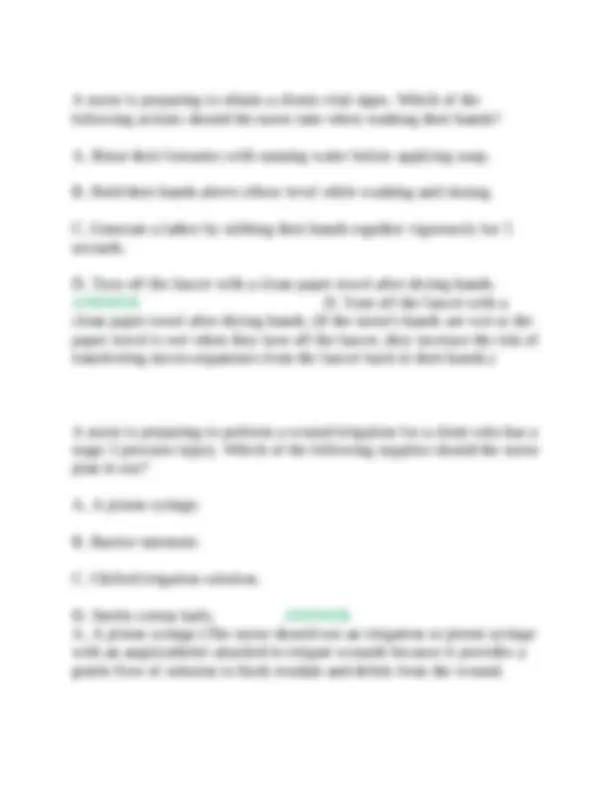
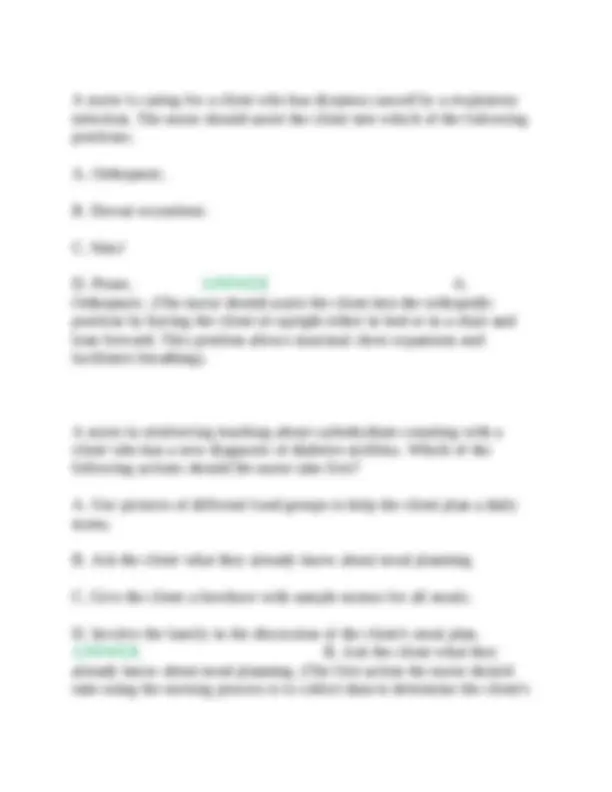
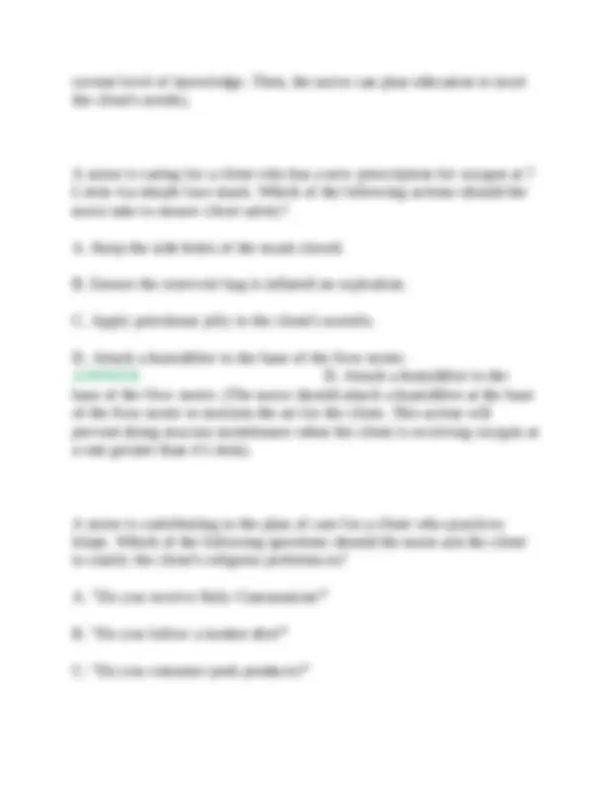
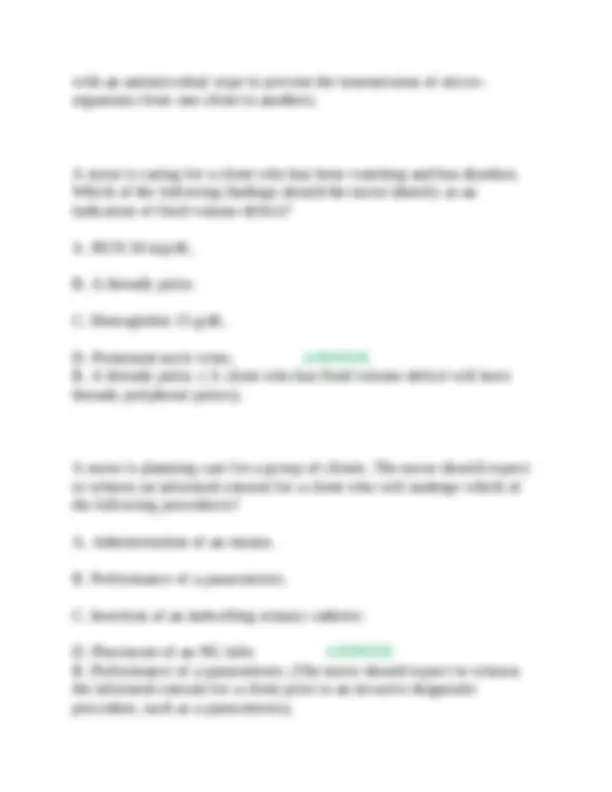
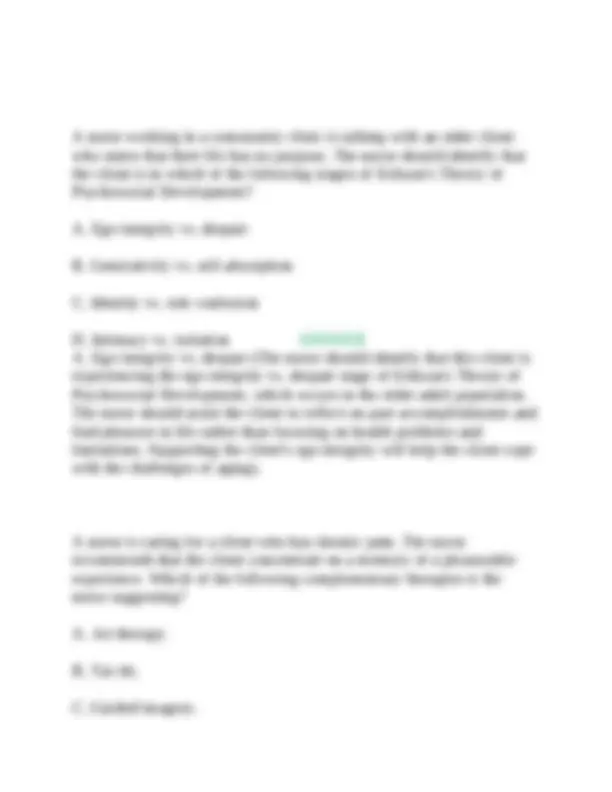
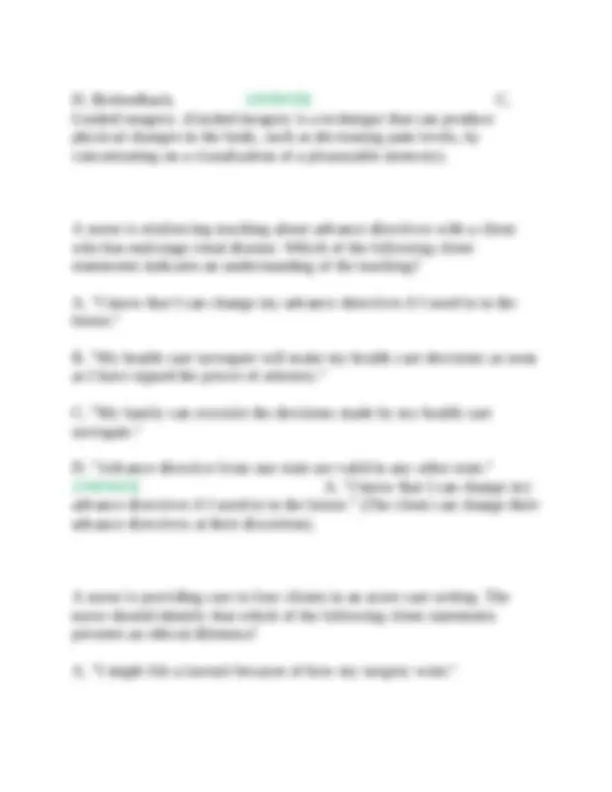
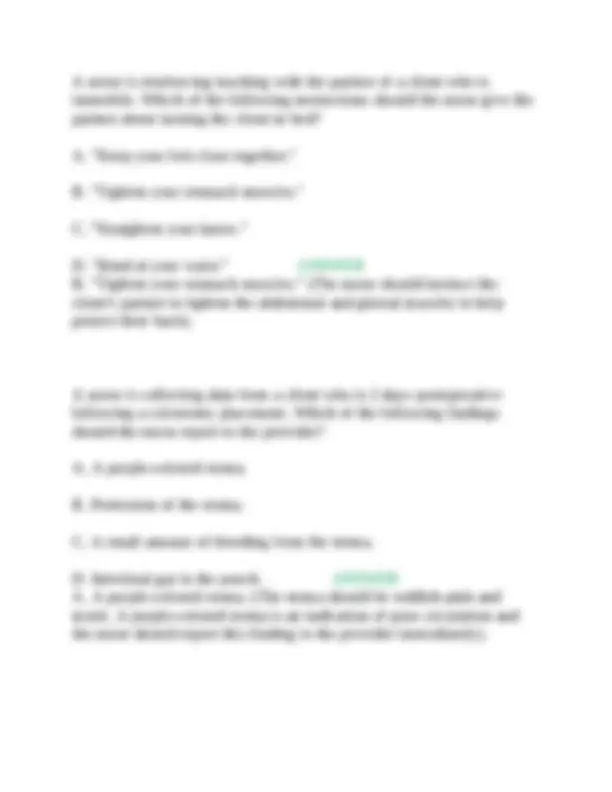
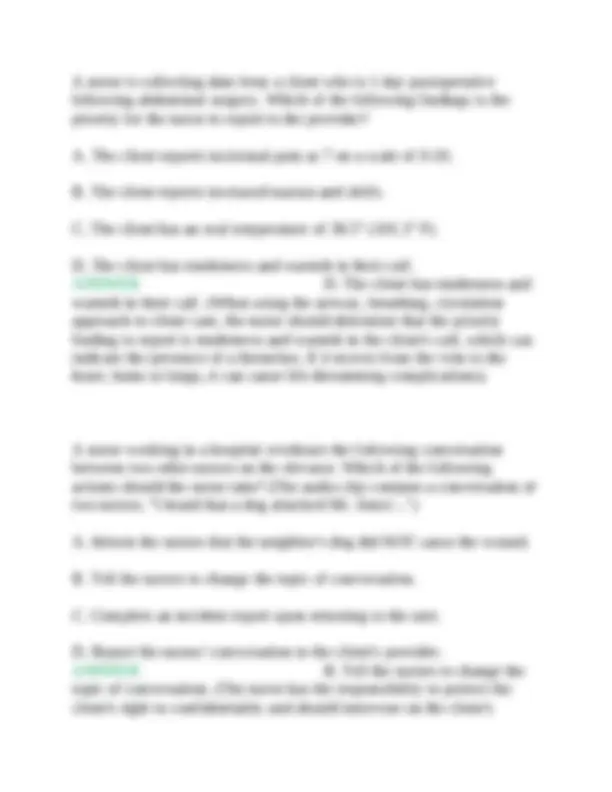
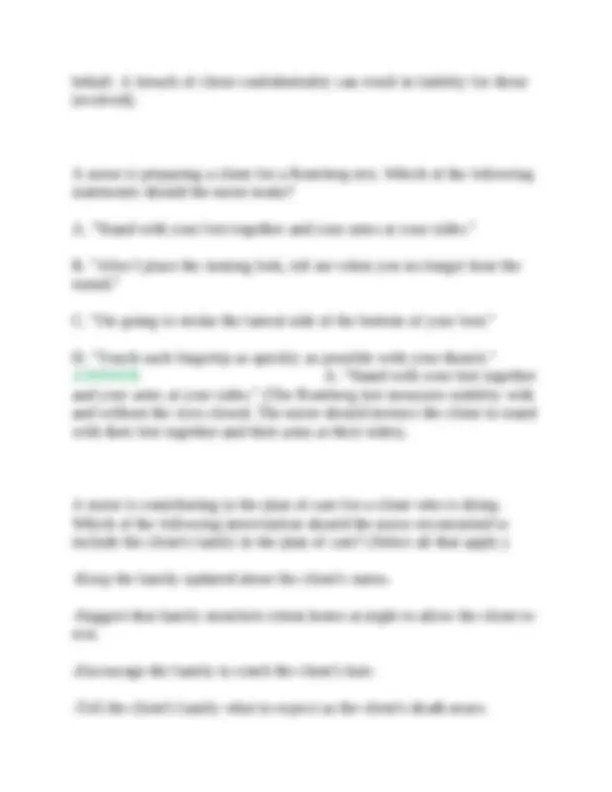
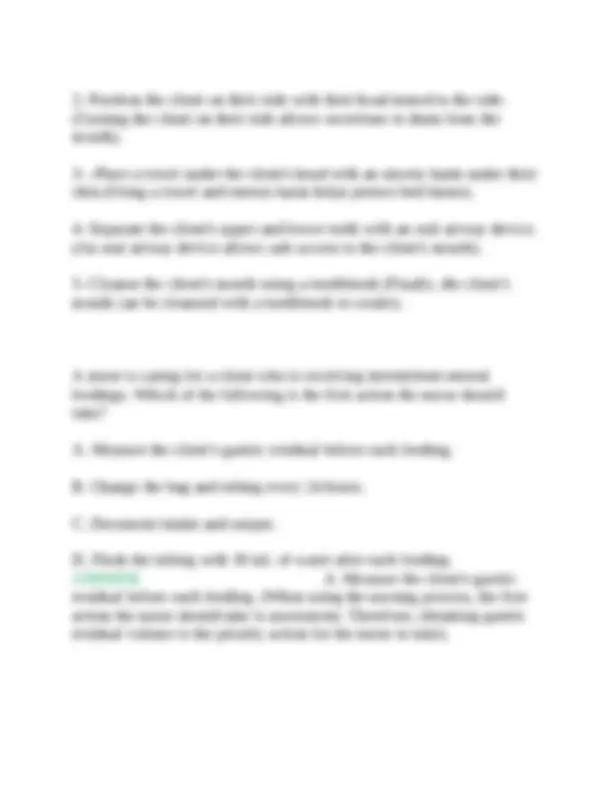
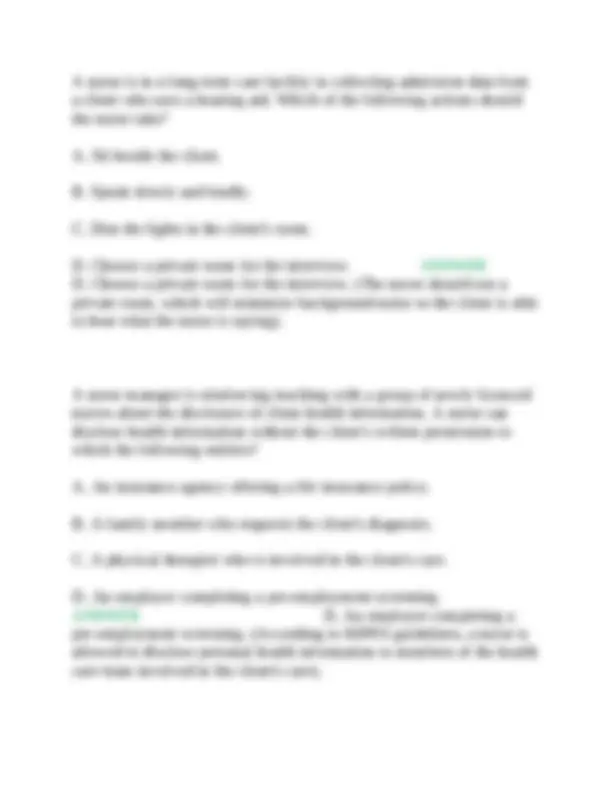
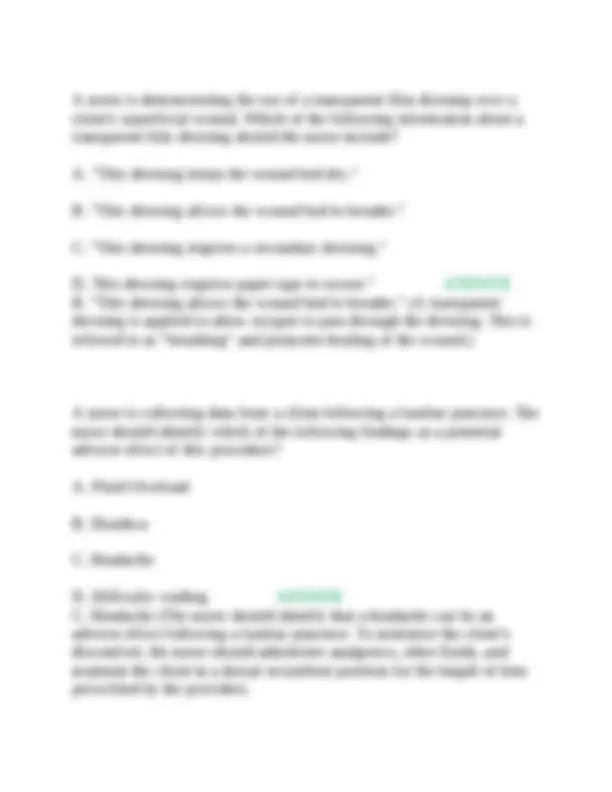
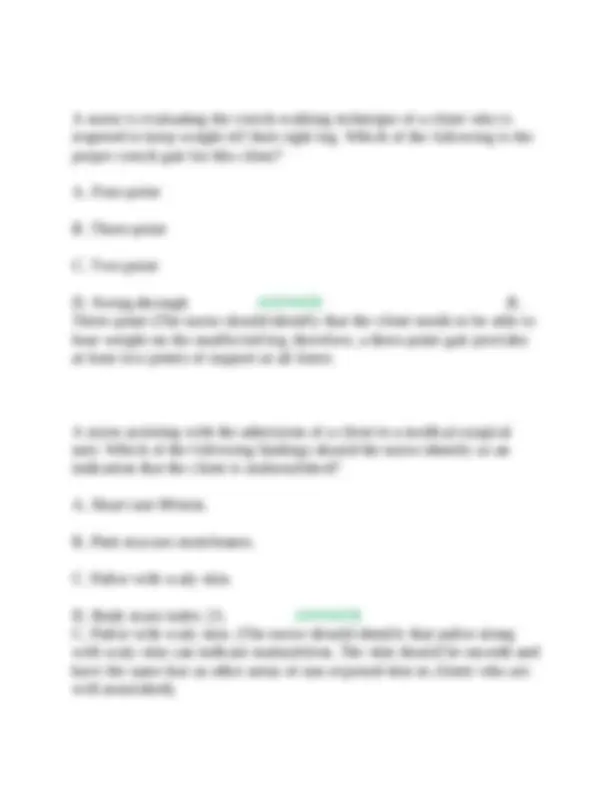
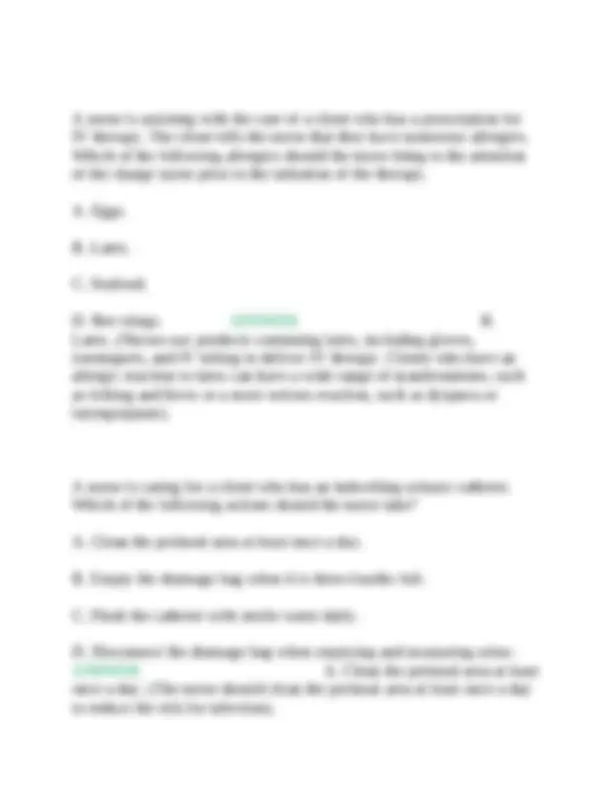
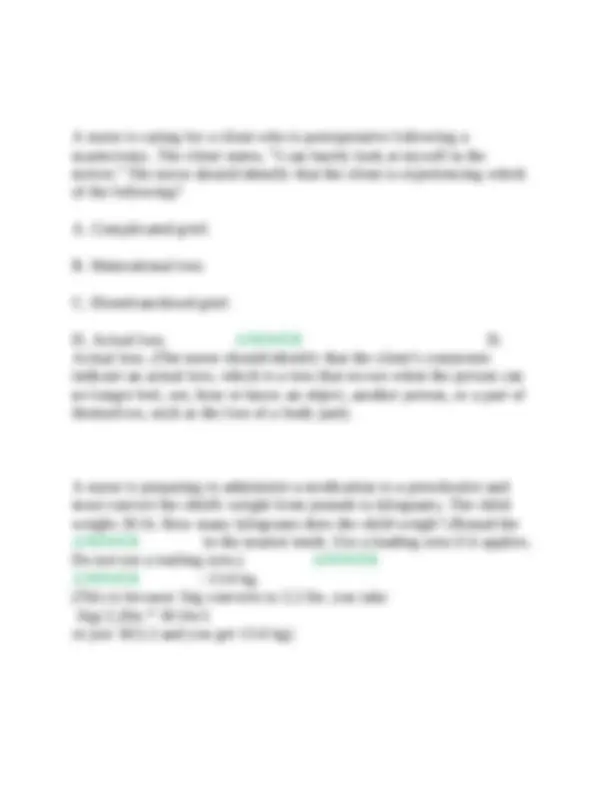
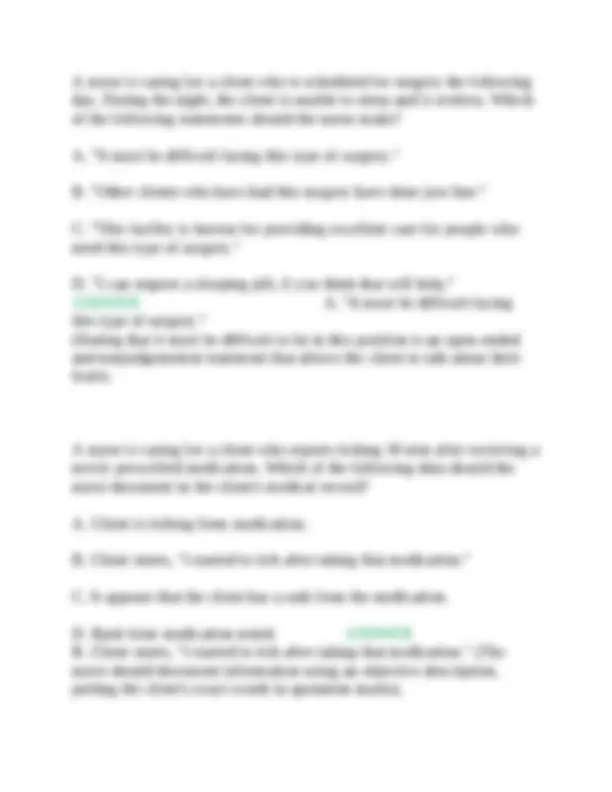
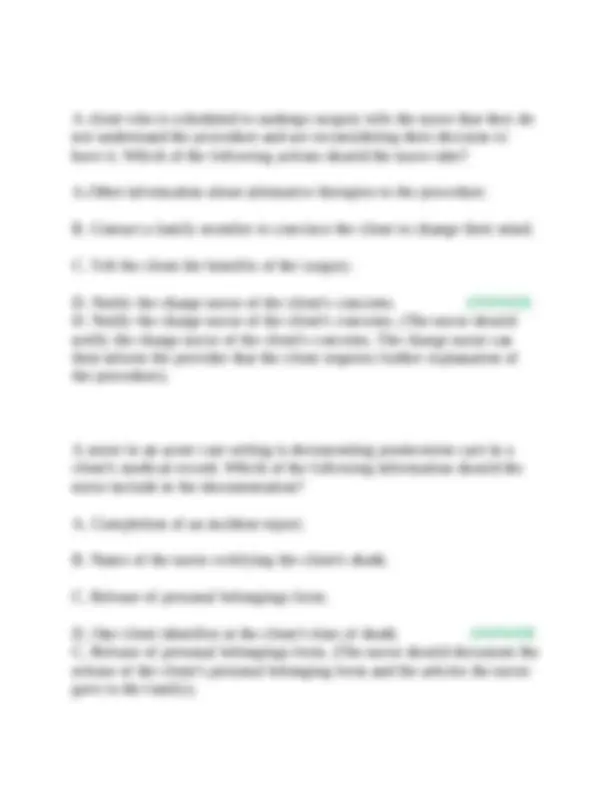
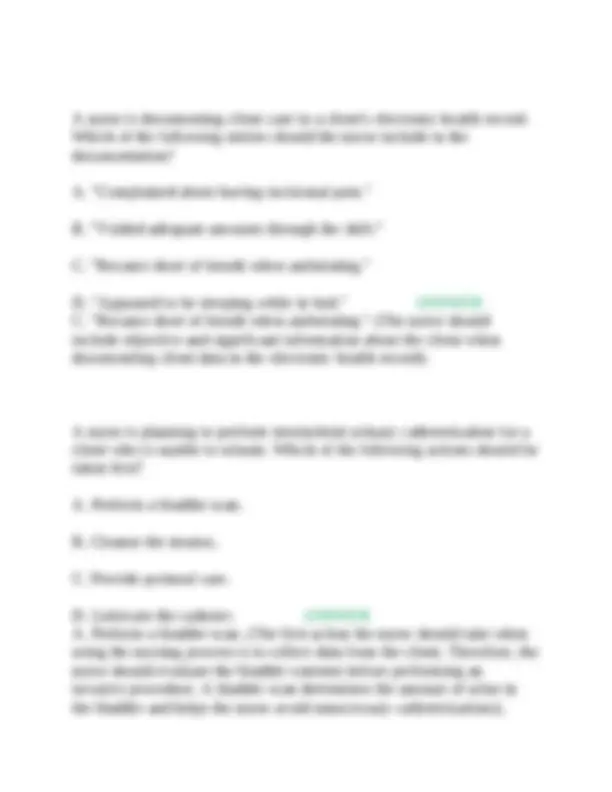
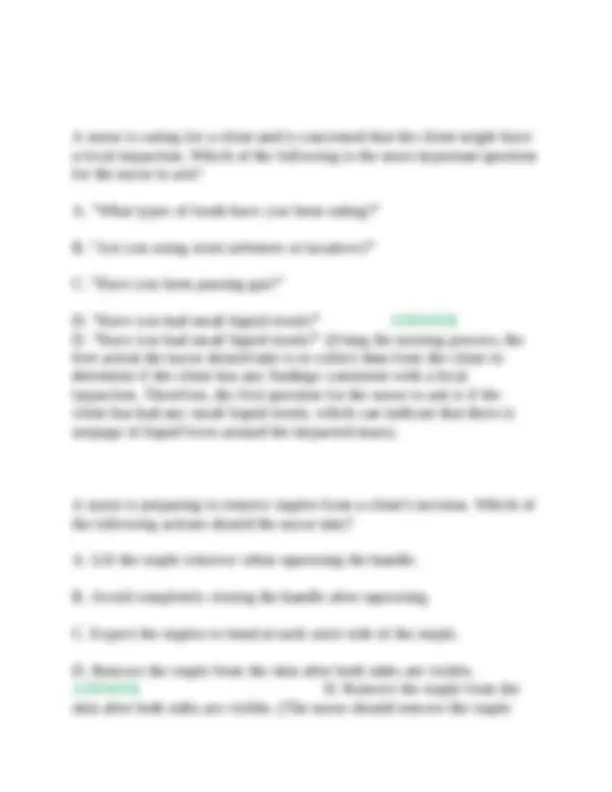
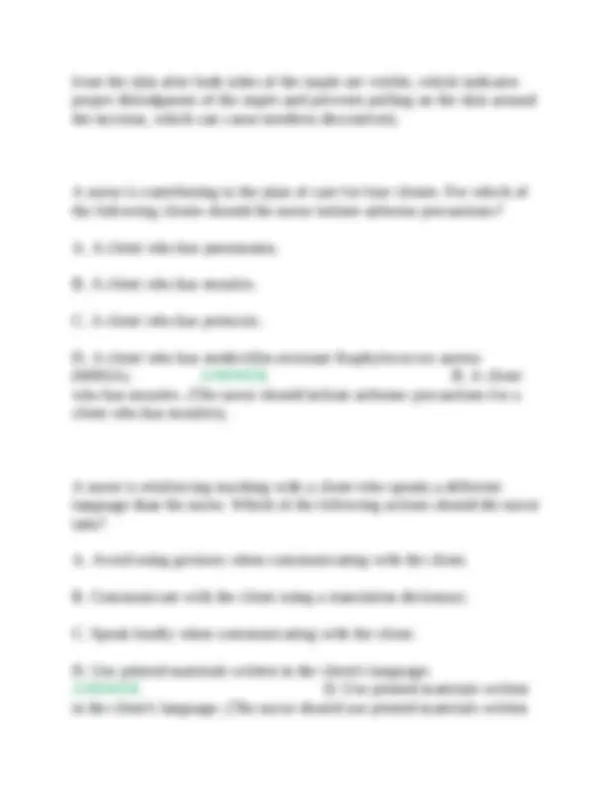
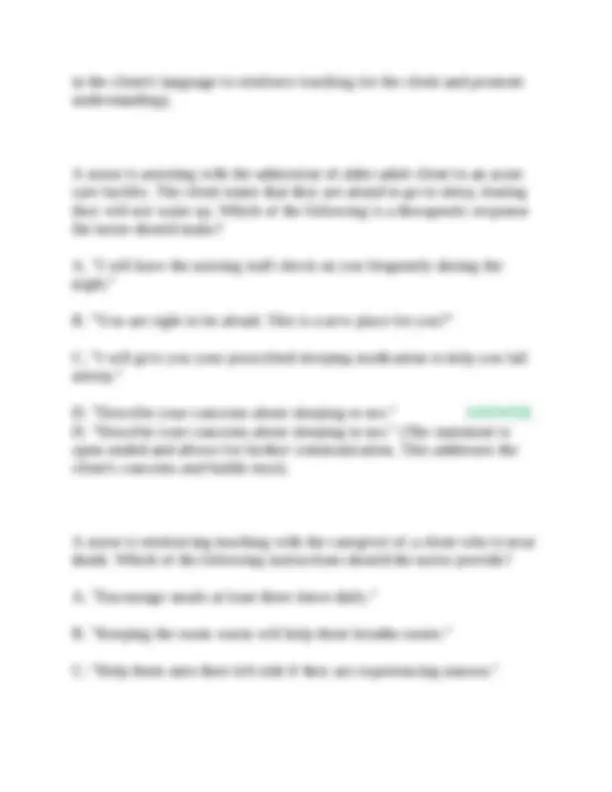
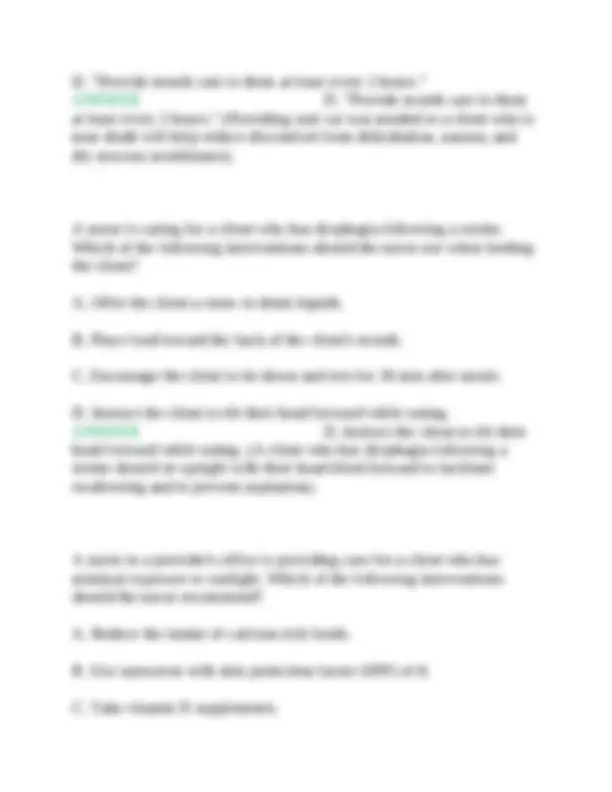
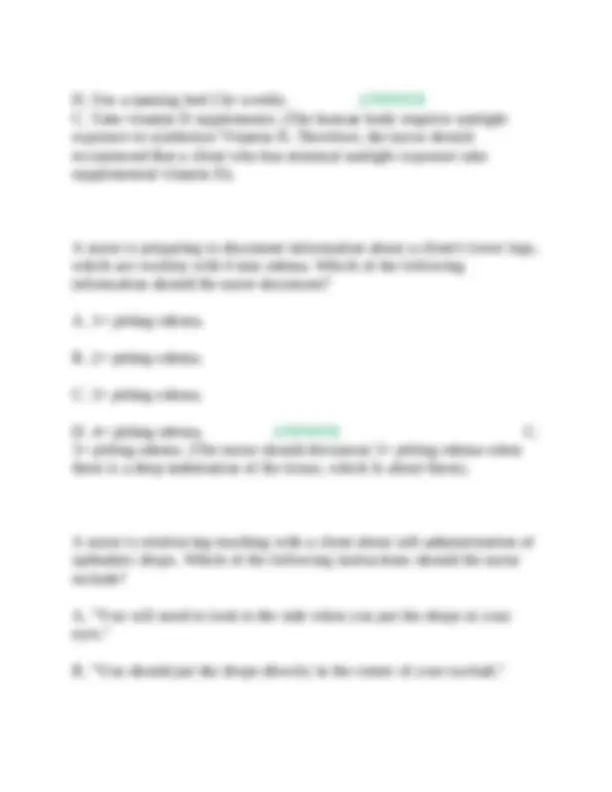
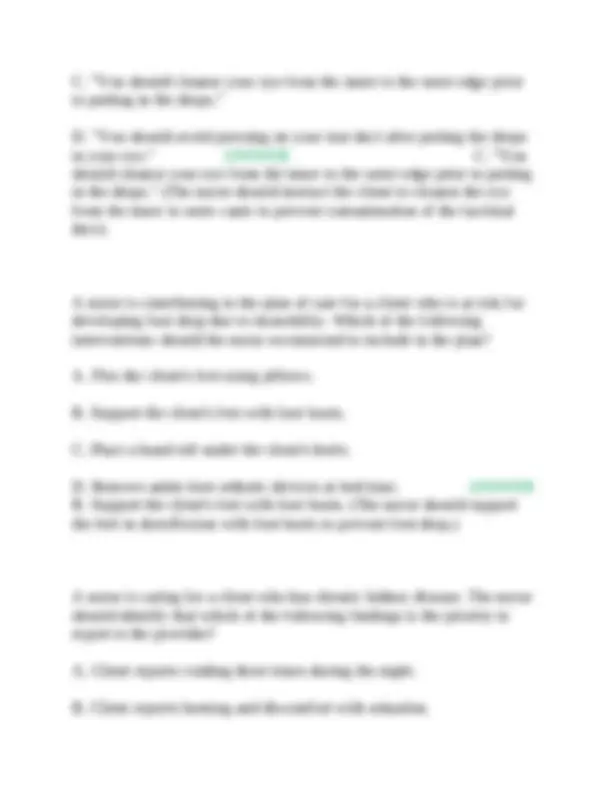
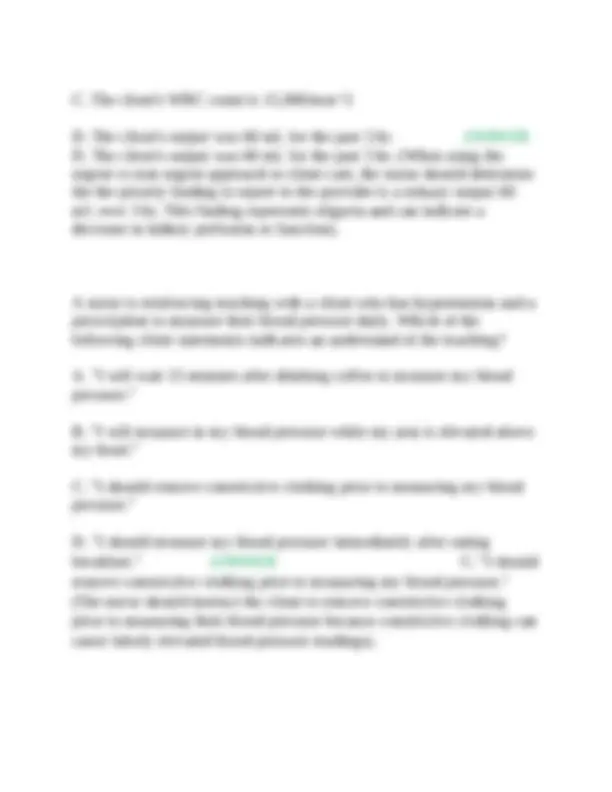


Study with the several resources on Docsity

Earn points by helping other students or get them with a premium plan


Prepare for your exams
Study with the several resources on Docsity

Earn points to download
Earn points by helping other students or get them with a premium plan
Community
Ask the community for help and clear up your study doubts
Discover the best universities in your country according to Docsity users
Free resources
Download our free guides on studying techniques, anxiety management strategies, and thesis advice from Docsity tutors
A series of multiple-choice questions and answers covering various aspects of nursing fundamentals. it tests knowledge on infection control, client preparation for procedures, vital signs assessment, therapeutic communication, and client care. the questions are valuable for nursing students to assess their understanding of key concepts and best practices.
Typology: Exams
1 / 33

This page cannot be seen from the preview
Don't miss anything!


























A nurse is planning to administer medication to a client who has a Clostridium difficile infection. Which of the following actions should the nurse plan to take to prevent the transmission of this infection to others? A. Clean hands with an alcohol-based hand rub immediately after removing gloves. B. Remove the cover gown in the client's room after providing care. C. Place the client in a room with negative-pressure airflow D. Wear a mask when administering oral medications to the client. ANSWER B. Remove the cover gown in the client's room after providing care. (The nurse should initiate contact precautions for clients who have a C. difficile infection. Contact precautions include the removal of the cover gown and other personal protective equipment inside the client's room to prevent the spread of infection). A nurse is reinforcing teaching with a client who is scheduled for a bladder scan. Which of the following instructions should the nurse include in the teaching?
A. "You will need to sign a consent form before we begin the procedure." B. "I will place a gel pad directly above your pubic area before I place the probe." C. "You will need to hold your urine for 1 hour prior to the procedure." D. "You will receive a contrast dye through an IV catheter prior to the scan." ANSWER B. "I will place a gel pad directly above your pubic area before I place the probe." (The nurse should use a gel pad, which promotes ultrasound transmission and accurate measurement. The correct placement of the ultrasound device is just above the symphysis pubis.) A nurse is checking a client for a pulse deficit after detecting an irregular heart rate. Which of the following actions should the nurse take? A. Count the client's radial and apical pulses simultaneously with another nurse. B. Calculate the client's pulse for 30 seconds and multiply by 2. C. Assist the client to a side-lying position. D. Auscultate the area of the client's chest over the Erb's point. ANSWER A. Count the client's radial and apical pulses simultaneously with another nurse. (The nurse should have another nurse count the radial pulse as they count the apical pulse. A pulse deficit occurs when there are differences between the radial and apical pulse rates.)
A nurse is caring for a client who has dyspnea caused by a respiratory infection. The nurse should assist the client into which of the following positions. A. Orthopneic. B. Dorsal recumbent. C. Sims' D. Prone. ANSWER A. Orthopneic. (The nurse should assist the client into the orthopedic position by having the client sit upright either in bed or in a chair and lean forward. This position allows maximal chest expansion and facilitates breathing). A nurse in reinforcing teaching about carbohydrate counting with a client who has a new diagnosis of diabetes mellitus. Which of the following actions should the nurse take first? A. Use pictures of different food groups to help the client plan a daily menu. B. Ask the client what they already know about meal planning. C. Give the client a brochure with sample menus for all meals. D. Involve the family in the discussion of the client's meal plan. ANSWER B. Ask the client what they already know about meal planning. (The first action the nurse should take using the nursing process is to collect data to determine the client's
current level of knowledge. Then, the nurse can plan education to meet the client's needs). A nurse is caring for a client who has a new prescription for oxygen at 7 L/min via simple face mask. Which of the following actions should the nurse take to ensure client safety? A. Keep the side holes of the mask closed. B. Ensure the reservoir bag is inflated on expiration. C. Apply petroleum jelly to the client's nostrils. D. Attach a humidifier to the base of the flow meter. ANSWER D. Attach a humidifier to the base of the flow meter. (The nurse should attach a humidifier at the base of the flow meter to moisten the air for the client. This action will prevent dying mucous membranes when the client is receiving oxygen at a rate greater than 4 L/min). A nurse is contributing to the plan of care for a client who practices Islam. Which of the following questions should the nurse ask the client to clarify the client's religious preferences? A. "Do you receive Holy Communion?" B. "Do you follow a kosher diet?" C. "Do you consume pork products?"
D. A client who has just experienced the death of their child. ANSWER D. A client who has just experienced the death of their child. (Silence is a therapeutic communication technique to use when a client is grieving. It demonstrates caring and patience and allows the client to speak when they are ready to do so). A nurse is caring for a group of clients in a long-term care facility. Which of the following actions should the nurse take to prevent health care-associated infections for these clients? (Select all that apply) -Place immunocompromised clients in the same room. -Wash hands after removing gloves. -Use antimicrobial hand gel after refilling a client's water pitcher -Clean the stethoscope with an antimicrobial wipe after obtaining vital signs. -Administer a prophylactic dose of antibiotics prior to discharge. ANSWER -Wash hands after removing gloves. (The nurse should perform hand hygiene after removing gloves to prevent the transmission of micro-organisms from one setting or client to another). -Use antimicrobial hand gel after refilling a client's water pitcher (The nurse should perform hand hygiene after touching a client's supplies to prevent the transmission of micro-organisms). -Clean the stethoscope with an antimicrobial wipe after obtaining vital signs. (The nurse should wipe all equipment used for multiple clients
with an antimicrobial wipe to prevent the transmission of micro- organisms from one client to another). A nurse is caring for a client who has been vomiting and has diarrhea. Which of the following findings should the nurse identify as an indication of fluid volume deficit? A. BUN 18 mg/dL. B. A thready pulse. C. Hemoglobin 15 g/dL. D. Prominent neck veins. ANSWER B. A thready pulse. ( A client who has fluid volume deficit will have thready peripheral pulses). A nurse is planning care for a group of clients. The nurse should expect to witness an informed consent for a client who will undergo which of the following procedures? A. Administration of an enema. B. Performance of a paracentesis. C. Insertion of an indwelling urinary catheter. D. Placement of an NG tube. ANSWER B. Performance of a paracentesis. (The nurse should expect to witness the informed consent for a client prior to an invasive diagnostic procedure, such as a paracentesis).
D. Biofeedback. ANSWER C. Guided imagery. (Guided imagery is a technique that can produce physical changes in the body, such as decreasing pain levels, by concentrating on a visualization of a pleasurable memory). A nurse is reinforcing teaching about advance directives with a client who has end-stage renal disease. Which of the following client statements indicates an understanding of the teaching? A. "I know that I can change my advance directives if I need to in the future." B. "My health care surrogate will make my health care decisions as soon as I have signed the power of attorney." C. "My family can overrule the decisions made by my health care surrogate." D. "Advance directive from one state are valid in any other state." ANSWER A. "I know that I can change my advance directives if I need to in the future." (The client can change their advance directives at their discretion). A nurse is providing care to four clients in an acute care setting. The nurse should identify that which of the following client statements presents an ethical dilemma? A. "I might file a lawsuit because of how my surgery went."
B. "Please don't tell my doctor, but I am taking my partner's oxycodone." C. "Please don't get me out of bed this morning. It hurts too much." D. "I don't want to take my medicine. It makes me sick to my stomach." ANSWER B. "Please don't tell my doctor, but I am taking my partner's oxycodone." ( This situation poses an ethical dilemma for the nurse because there is a conflict between what the client is asking of the nurse and the nurse's responsibility to protect the client from harm during hospitalization). A nurse is caring for a client who has a new diagnosis of cancer. Which of the following actions by the nurse maintains the client's confidentiality? A. Sharing the client's prognosis with a member of the client's family. B. Discussing the client's status with a member of the spiritual support team. C. Collaborating with a nurse from another unit about the client's care. D. Providing client information to another nurse at change of shift. ANSWER D. Providing client information to another nurse at change of shift. (The nurse can share information with other staff who are caring for the client because it is essential to maintaining continuity of care, and does not violate the client's confidentiality. The nurse should only share information about the client with those directly involved in the client's care).
A nurse is reinforcing teaching with the partner of a client who is immobile. Which of the following instructions should the nurse give the partner about turning the client in bed? A. "Keep your feet close together." B. "Tighten your stomach muscles." C. "Straighten your knees." D. "Bend at your waist." ANSWER B. "Tighten your stomach muscles." (The nurse should instruct the client's partner to tighten the abdominal and gluteal muscles to help protect their back). A nurse is collecting data from a client who is 2 days postoperative following a colostomy placement. Which of the following findings should the nurse report to the provider? A. A purple-colored stoma. B. Protrusion of the stoma. C. A small amount of bleeding from the stoma. D. Intestinal gas in the pouch. ANSWER A. A purple-colored stoma. (The stoma should be reddish-pink and moist. A purple-colored stoma is an indication of poor circulation and the nurse should report this finding to the provider immediately).
A nurse is collecting data from a client who is 1 day postoperative following abdominal surgery. Which of the following findings is the priority for the nurse to report to the provider? A. The client reports incisional pain as 7 on a scale of 0-10. B. The client reports increased nausea and chills. C. The client has an oral temperature of 38.5° (101.3° F). D. The client has tenderness and warmth in their calf. ANSWER D. The client has tenderness and warmth in their calf. (When using the airway, breathing, circulation approach to client care, the nurse should determine that the priority finding to report is tenderness and warmth in the client's calf, which can indicate the presence of a thrombus. If it moves from the vein to the heart, brain or lungs, it can cause life-threatening complications). A nurse working in a hospital overhears the following conversation between two other nurses on the elevator. Which of the following actions should the nurse take? (The audio clip contains a conversation of two nurses, "I heard that a dog attacked Mr. Jones'...") A. Inform the nurses that the neighbor's dog did NOT cause the wound. B. Tell the nurses to change the topic of conversation. C. Complete an incident report upon returning to the unit. D. Report the nurses' conversation to the client's provider. ANSWER B. Tell the nurses to change the topic of conversation. (The nurse has the responsibility to protect the client's right to confidentiality and should intervene on the client's
A nurse is reinforcing teaching with a new parent who is concerned about sudden infant death syndrome (SIDS). Which of the following statements by the client indicates an understanding of the teaching? A. "I will place my baby on her side to sleep." B. "I should avoid giving my baby a pacifier." C. "I will remove all stuffed animals from my baby's crib." D. "I will cover my baby with a light blanket when she is sleeping." ANSWER C. "I will remove all stuffed animals from my baby's crib." (The nurse should reinforce the need to remove all stuffed animals and toys when the infant is sleeping to reduce the risk for SIDS). A nurse is providing oral hygiene for a client who is unconscious. Identify the sequence of the steps the nurse should take. (Move the steps into the box in order of performance) -Place a towel under the client's head with an emesis basin under their chin. -Assess the client's gag reflex. -Cleanse the client's mouth using a toothbrush. -Separate the client's upper and lower teeth with an oral airway device. -Position the client on their side with their head turned to the side. ANSWER 1- Assess the client's gag reflex. (The nurse should first assess the client's gag reflex to determine risk for aspiration)
A nurse is in a long-term care facility in collecting admission data from a client who uses a hearing aid. Which of the following actions should the nurse take? A. Sit beside the client. B. Speak slowly and loudly. C. Dim the lights in the client's room. D. Choose a private room for the interview. ANSWER D. Choose a private room for the interview. (The nurse should use a private room, which will minimize background noise so the client is able to hear what the nurse is saying). A nurse manager is reinforcing teaching with a group of newly licensed nurses about the disclosure of client health information. A nurse can disclose health information without the client's written permission to which the following entities? A. An insurance agency offering a life insurance policy. B. A family member who requests the client's diagnosis. C. A physical therapist who is involved in the client's care. D. An employer completing a pre-employment screening. ANSWER D. An employer completing a pre-employment screening. (According to HIPPA guidelines, a nurse is allowed to disclose personal health information to members of the health care team involved in the client's care).
A nurse is demonstrating the use of a transparent film dressing over a client's superficial wound. Which of the following information about a transparent film dressing should the nurse include? A. "This dressing keeps the wound bed dry." B. "This dressing allows the wound bed to breathe." C. "This dressing requires a secondary dressing." D. This dressing requires paper tape to secure." ANSWER B. "This dressing allows the wound bed to breathe." (A transparent dressing is applied to allow oxygen to pass through the dressing. This is referred to as "breathing" and promotes healing of the wound.) A nurse is collecting data from a client following a lumbar puncture. The nurse should identify which of the following findings as a potential adverse effect of this procedure? A. Fluid Overload B. Diarrhea C. Headache D. Difficulty voiding ANSWER C. Headache (The nurse should identify that a headache can be an adverse effect following a lumbar puncture. To minimize the client's discomfort, the nurse should administer analgesics, other fluids, and maintain the client in a dorsal recumbent position for the length of time prescribed by the provider).